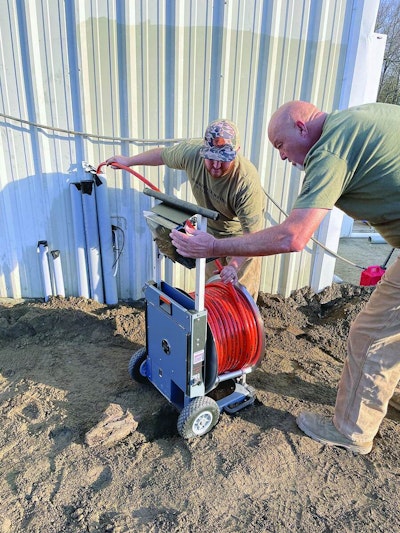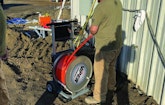
Mason Powell, a technician for Stokes Plumbing & Trenchless, uses a Viper combination camera and jetter to inspect and clean a 36-inch-diameter stormwater sewer at a business in Georgia.
Interested in Inspection?
Get Inspection articles, news and videos right in your inbox! Sign up now.
Inspection + Get AlertsCleaning and inspecting a clogged sewer line simultaneously may sound as improbable as an old clay-pipe lateral with no offsets.
But it’s an everyday reality for technicians at Stokes Plumbing & Trenchless thanks to the Viper combination camera and jetter from Envirobot. Technicians can use the jetting function to easily steer the unit into one or multiple branch lines, which improves productivity, says Wesley Stokes, owner of the Florence, South Carolina, company.
“I first saw the Viper at the Water & Wastewater Equipment, Treatment & Transport (WWETT) Show,” says Stokes, who established his company in 2008. “We thought it would be a great addition mainly because it’s basically steerable. When you get to a junction, you can steer it one way or another. You can also jet a line while televising it — guys can see what they’re doing while they’re working on a clog. And we can provide customers with a video of the line that shows what’s causing the clog. It’s a really good deliverable to give to our customers at the end of a job.”
Unclogging drainlines doesn’t always require an inspection, Stokes notes. But when an inspection is required, the Viper can eliminate the usual painstaking cycle of insert camera, insert jetter, insert camera again and insert jetter again.
“There is some time and labor savings there when you can consolidate those steps,” Stokes says.
Technology spurs growth
Stokes bought his first Viper, a Long Range model, about 12 years ago. (Envirobot also offers Viper Compact and Viper Light models.) Now Stokes Plumbing — which has about 40 full-time employees, runs around 25 service vehicles and does commercial and industrial plumbing and repair work for customers nationwide — owns 10 Viper Long Range machines, which is a testament to their value, Stokes says.
To use a Viper, contractors need a water jetter that generates at least 1,600 psi of pressure and 8 gpm of flow. Stokes Plumbing relies on water jetters made by Harben (a subsidiary of Flowplant Group Ltd.) and Mongoose (a brand owned by Sewer Equipment).
The company primarily uses the Vipers to clean sanitary sewer and stormwater lines, Stokes says.
Investing in newer, productivity-enhancing technology like the Vipers has been instrumental to the company’s growth, which has come through landing large national and regional accounts.
“Serving big national customers absolutely makes it important to keep investing in advanced equipment,” Stokes says. “They want to do business with companies that have well-trained, well-equipped guys that do jobs right and charge a fair price. And those kinds of companies are hard to find in today’s market.
“Once these large accounts find a company that comes in and does exactly what they say they’re going to do, they really appreciate it. And they’re willing to pay a little bit of a premium because we figure out what’s causing a clog and we don’t leave until the problem is resolved.”
It also pays dividends when businesses like Stokes Plumbing offer diversified services because it’s more cost-effective to pay one company to clean and inspect a line — then repair it if needed — than it is to hire a company to clean and camera a line and then hire another company to perform repairs, Stokes says.
The company also does pipe lining with a system from Perma-Liner Industries.
Steering toward profitability
The portable Viper Long Range weighs about 139 pounds and measures 23 inches wide by 25 inches deep by 28 inches high (with a telescoping handle retracted). It comes with 265 feet of 3/8-inch-diameter hose and features an ergonomically designed, two-wheel handcart.
The Viper’s camera cable is integrated into the jacket of the high-pressure hose, which optimizes handling and protects against damage. The machines are designed to work in pipes from 3 to 16 inches in diameter and the camera and nozzle can pass through 45-degree bends in pipes 3 inches in diameter or larger and 90-degree bends in pipes that are 4 inches in diameter or larger.
The high-resolution, stainless steel camera features digital-zoom capability and a 160-degree, wide-angle lens; dimmable LED lights; a sensor that indicates inclination and direction; and a locator sonde.
To steer the unit, the operator rotates the hose in the desired direction.
Good ROI
The Vipers cost about $27,300 each these days, but Stokes says they pay for themselves quickly through improved productivity, not to mention enhanced client retention that stems from providing great service.
“Any piece of equipment that pays for itself in two to three years and lasts more than 10 years, like our older Vipers have, is a pretty good investment,” Stokes says. “I like them, our guys like them and our clients like them. It’s a win-win-win situation.”







